Maritime Satellite Communication Market Size
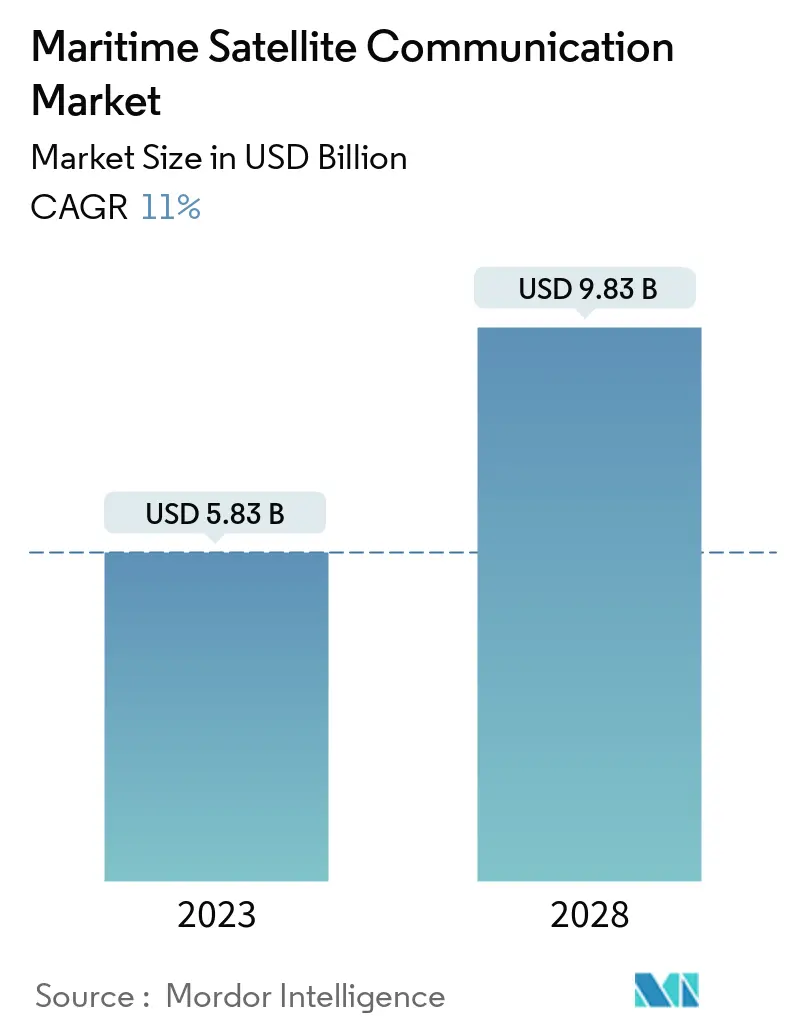
| Study Period | 2018 - 2028 |
| Market Size (2023) | USD 5.83 Billion |
| Market Size (2028) | USD 9.83 Billion |
| CAGR (2023 - 2028) | 11.00 % |
| Fastest Growing Market | Asia-Pacific |
| Largest Market | North America |
Major Players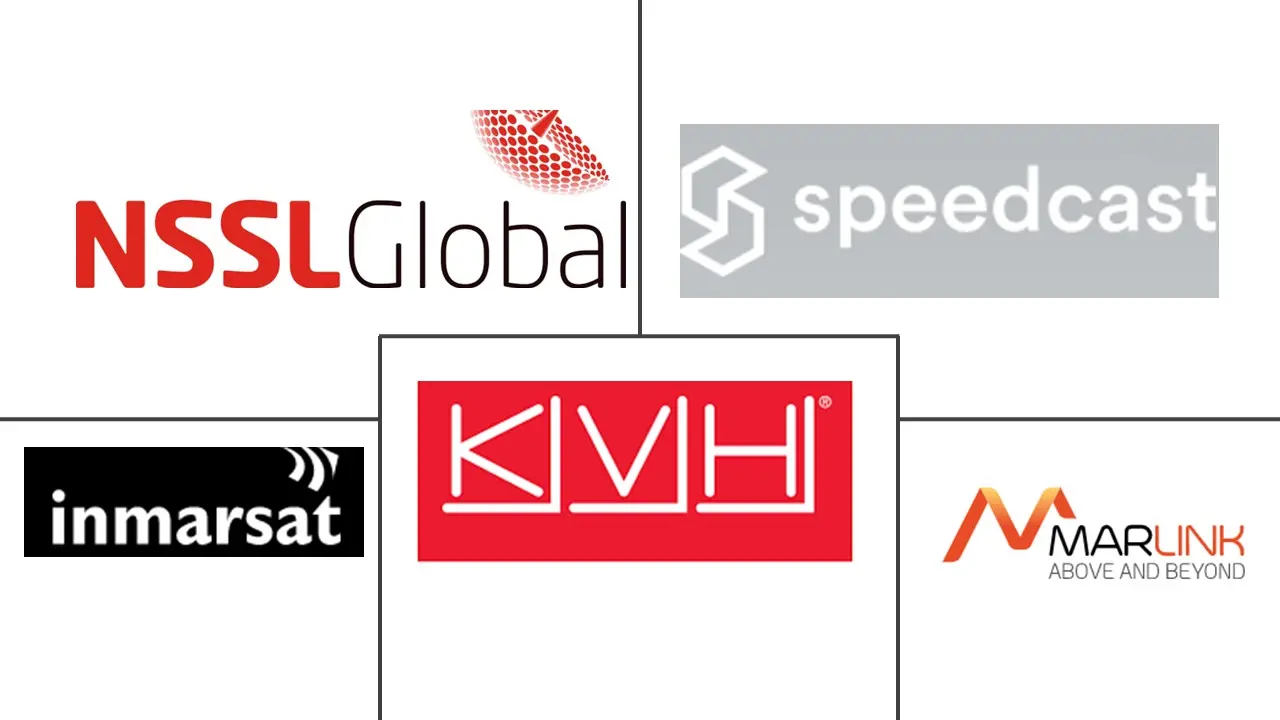
*Disclaimer: Major Players sorted in no particular order |
Need a report that reflects how COVID-19 has impacted this market and its growth?
Maritime Satellite Communication Market Analysis
The Maritime Satellite Communication Market size is estimated at USD 5.83 billion in 2023, and is expected to reach USD 9.83 billion by 2028, growing at a CAGR of 11% during the forecast period (2023-2028).
The main drivers of market growth include rising demand for broadband connections, VSAT connectivity, and high-throughput satellites to enable cloud and IoT applications. However, an absence of knowledge about advanced maritime satellite services impedes business expansion. The market sizing estimates reflect the spending on maritime satellite communication by different end users and regions.
- The ability to track ships and cargo worldwide is made possible by satellite communication systems. VSAT terminals are communication devices that enable text, audio, and video data transmission and reception over satellite-based broadband internet services. These terminals function as geostationary satellites on the Ku, Ka, and C bands. Service providers would need even greater capacity, coverage, performance, and flexibility to meet the changing needs of the whole maritime industry, where end users have a wide range of communication needs. Additionally, they must be able to grow networks to meet consumer demands swiftly. Customers are having trouble using satellite solutions due to the growing use of maritime satellite technologies.
- Crew welfare is made possible by digitalization's quick connectivity for VoIP conversations, messengers, and video conferencing. Smaller ships typically lack the room or space for an expensive satellite communications setup while large ships are quickly adopting new methods of digitalization by VSAT communications. Orion Edge V provides a VSAT-like experience on little hardware for all vessels and allows for optimized applications through the OneGate platform for video conferencing, telemedicine, remote maintenance, and IoT. With voice services provided through the Thuraya MarineStarterminal acting as an onboard public phone and data services delivered over the Thuraya Orion IP broadband terminal acting as the first line of communications, it can be used as the main communications system for small vessels.
- A communication satellite known as a high-throughput satellite, or HTS, has greater throughput than standard communication satellites. Higher throughput is a large improvement in capacity when utilizing the same amount of orbital spectrum. The capacity increase typically varies from 2 to more than 100 times that of the conventional FSS, which greatly reduces the cost per bit.
- According to the Global Star, the equipment and materials used to construct satellites affect their price. Maintenance of transponders cost hundreds of thousands of dollars each year, whereas bandwidth costs at least USD 3,500 per month. A 36MHz bandwidth satellite costs more than USD 1.5 million per year to operate. For the satellite to carry out its intended purpose, other devices and equipment must be integrated into it, such as computers, software, and cameras.
- The COVID-19 pandemic caused hockwaves across every industry worldwide. It significantly impacted the satellite communication industry. The industry's dependence on government contracts in various areas, including the highly reliable and survivable nature of satellite communications services that are essential for disaster communications and backup services, may insulate the industry from some of the more severe impacts of the global pandemic.
Maritime Satellite Communication Market Trends
This section covers the major market trends shaping the Maritime Satellite Communication Market according to our research experts:
Maritime Satilite Communication Service Offering to Hold Significant Market Share
- The growing ecosystem of maritime transportation and its benefits with the circular economy, such as decreasing carbon footprints and other aspects, coincide with the organizational goals of the companies and demands for data-driven maritime services. These are best bolstered with the satellite communication providers offering services for busy vessel routes.
- The increasing traffic on specific routes creates a considerable requirement for maritime satellite communication services for multiple shipping and maritime service providers. For instance, according to the survey of Basic Port Statistics of India 2020-2021 by the Ministry of Ports, Shipping and Waterways (India), the shipping ports in Gujarat handled about 505.14 million metric tons in FY 2021, followed by 159.48 million metric ton by Andhra Pradesh. The break bulk cargo handled by the Indian-flagged vessels in FY 2021 accounted for 10.4%, followed by containers at 3.8%, with the total gross value accounting for 5.6%.
- Such high demands and handling of shipping across the ports invite maritime communication service providers to offer their reliable services for efficient and responsive satellite communication to track the shipments correctly and accurately, ensuring safe delivery of the shipments. In December 2021, KVH Industries Inc. announced the launch of satellite connectivity services to allow vessels to use KVH connectivity while operating in Indian territorial waters. In addition, KVH will offer satellite connectivity services to Indian-flagged vessels. Station Satcom Private Ltd, an existing Mumbai-based KVH service provider, would be KVH’s distribution launch partner in India.
- Similarly, taking the Indian scenario forward, many public sectors are working on advancements to provide reliable satellite communication services to their shipping counterparts. In January 2022, ONGC, one of India’s largest oil and gas producers, chose Nelco, a satellite service provider, to upgrade its in-house Ku-band satellite communication system, enabling high-speed data and voice services for its sites off India’s western shoreline. According to Nelco, the strategic advancement may improve connectivity among ONGC’s offshore platforms, drilling rigs, vessels, and onshore locations, improving the company’s everyday operations and the life of its crew. The project expects to incur costs of around INR 400 million, which may include replacing ONGC’s existing system with an end-to-end IP network to support video, voice, and other forms of data, including application data.
- In different parts of the world, established wireless satellite communication service providers, including private players, are also entering the maritime communication spectrum through gradual advancements, providing profound connectivity to maritime customers. Such developments help build the ecosystem to bridge the gap between maritime satellite communication and the terrestrial bounds.
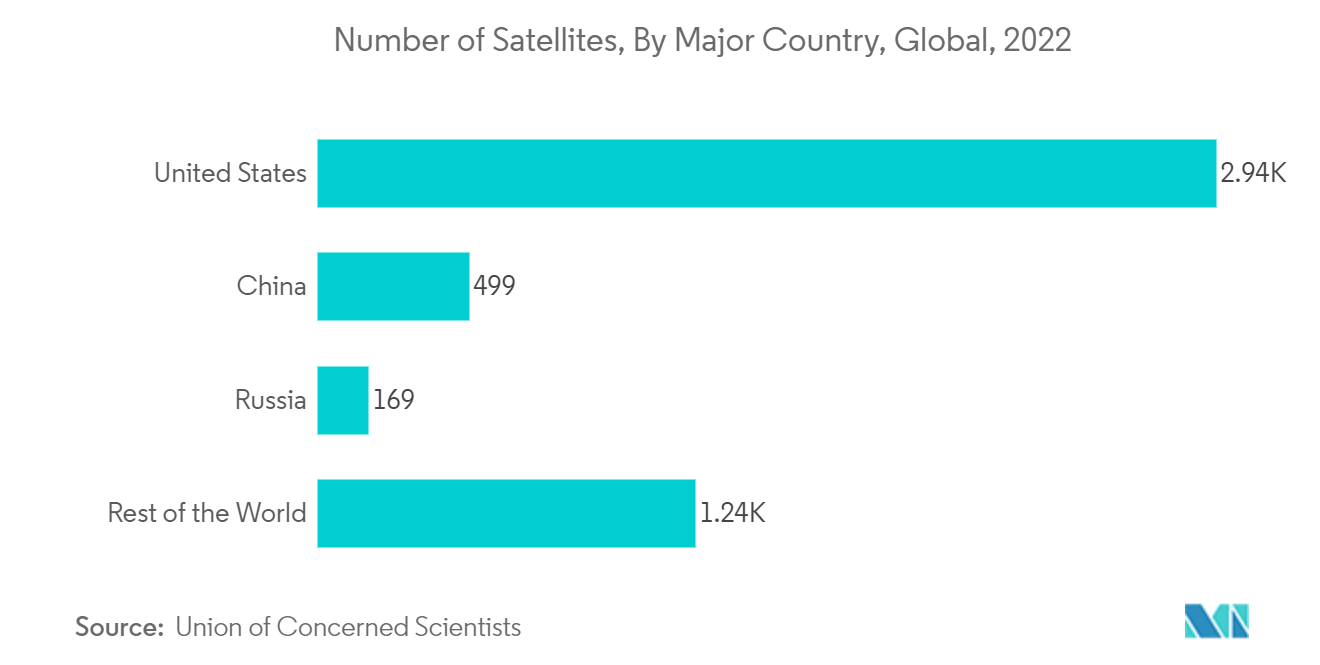
Asia-Pacific to Witness the Highest Growth
- Due to the rising use of waterways for transportation, the increasing government initiatives, and the expanding use of satellite communication, the Asia-Pacific region (predominantly in India, China, Japan, Malaysia, and Singapore) is anticipated to be the fastest-growing segment in the maritime analytics market between 2022 and 2027. In addition, the region's abundance of significant solution and service companies may foster market progress in Asia-Pacific.
- According to VesselsValue statistics, as of November 2021, China achieved the second position, with a total of USD 191 billion in assets. China has the most container ships in its fleet. As a result of the recent increase in rates and values, the country rose to the top position in terms of fleet value. Japan is ranked second, as per the same study. As owners' trust in the market soared in response to the rate hike, the container shipping industry went on an ordering spree. Since January 2021, 516 box ships have been ordered, with Chinese firms like OOCL, SITC, and COSCO Shipping placing 46% of these orders. Such an increase in container ships is expected to drive the market.
- According to the Broadband India Forum, the new standard for Interface Requirements for Communication & Broadcast Networks for fixed-satellite service-FSS/broadcasting-satellite service-BSS (mandatory technical requirements) may allow the ground segment very-small-aperture terminal (VSAT) players to take advantage of the latest SATCOM technologies (BIF).
- As per the Ministry of Ports, the Deendayal port in India handled 17.5% of total cargo in FY 2021, the highest percentage. Also, India had 224 ports as of 2021. There was a rise in the total number of ports, especially across the south Asian country, with seven additional minor ports added to the list. The nation had 212 minor ports and 12 major ports as of 2021. Hence, the rise in the number of ports in the region is creating a demand for monitoring shipping-related activities, which may, in turn, fuel the growth of the Asia-Pacific satellite communication market.
- In December 2021, the debut of satellite communication services by KVH Industries Inc., a global marine VSAT provider, was expected to enable ships to use KVH connectivity while operating in Indian territorial waters. In addition, KVH may provide satellite connectivity services to ships flying the Indian flag. The distribution launch partner for KVH in India will be Station Satcom Private Ltd, an existing provider of KVH services with headquarters in Mumbai. The purpose of KVH's VSAT services, which make use of Intelsat's FlexMaritime network, is to help the thousands of vessels that operate in Indian waters use of high-throughput satellite (HTS) technology's quick data rates and dependable connectivity.
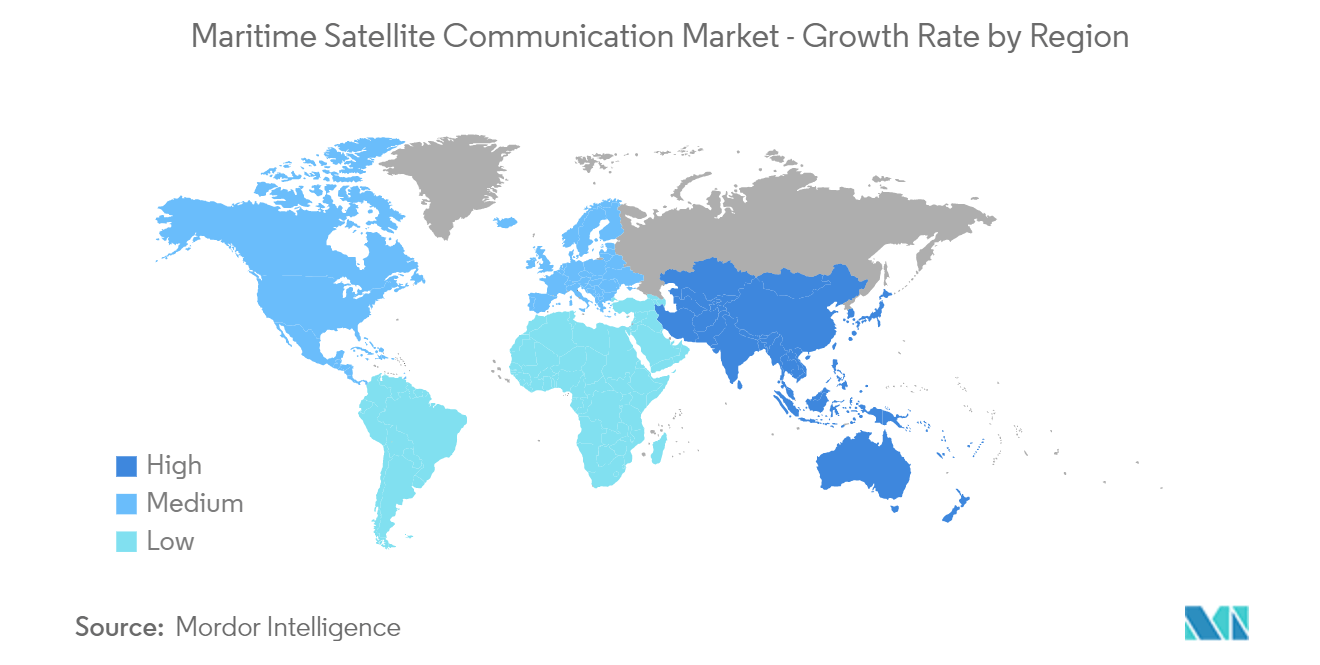
Maritime Satellite Communication Industry Overview
The maritime satellite communication market is highly competitive and consists of several major players. In terms of market share, few of the major players currently dominate the market. These major players, with a prominent market share, are focusing on expanding their customer base across foreign countries. These companies are leveraging strategic collaborative initiatives to increase their market share and increase their profitability.
- August 2022 - KVH partnered with the Hellenic Broadcasting Corporation (ERT) to serve Greek seafarers with native content through KVH Link, enhancing the content service focused on a large segment of the commercial maritime crew population. The new collaboration with ERT includes video and audio content available to seafarers directly on vessels enjoying KVH Link. Video content includes a one-hour news bulletin broadcast daily, keeping Greek seafarers up to date with the happenings in Greece and across the world.
- July 2022 - KVH introduces KVH ONE Hybrid Network and groundbreaking TracNet Terminals. Innovative terminals feature integrated satellite, cellular, and Wi-Fi technology with intelligent, automatic switching to keep boats connected to the best available communication option for fast, reliable connectivity at sea and at the dock.
Maritime Satellite Communication Market Leaders
Inmarsat Group Limited
Marlink SAS (Providence Equity Partners)
KVH Industries Inc.
Speedcast
NSSL Global Limited
*Disclaimer: Major Players sorted in no particular order
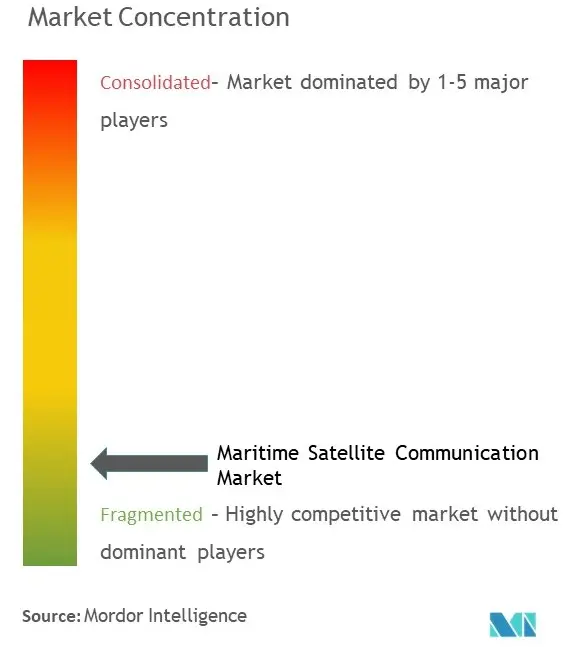
Maritime Satellite Communication Market News
- October 2022 - AXESS Networks and Viasat entered a strategic partnership to expand maritime services globally, which expect and need high-performing internet at sea. Viasat brings powerful offshore internet services within a specific maritime plan.
- September 2022 - NSSLGlobal launched its new VSAT IP@SEA on-demand customized connectivity packages. Customers can take advantage of its brand-new customized connectivity packages, which offer two excellent options to satisfy users' data needs. Operators can reserve dedicated bandwidth by the hour using the On-Demand Bandwidth Streaming service. With its range of customizable packages that can reach speeds of up to 150 Mbps, these services may give customers further control and independence over their service and bandwidth.
Maritime Satellite Communication Market Report - Table of Contents
1. INTRODUCTION
1.1 Study Assumptions and Market Definition
1.2 Scope of the Study
2. RESEARCH METHODOLOGY
3. EXECUTIVE SUMMARY
4. MARKET INSIGHTS
4.1 Market Overview
4.2 Industry Attractiveness - Porter's Five Forces Analysis
4.2.1 Threat of New Entrants
4.2.2 Bargaining Power of Buyers
4.2.3 Bargaining Power of Suppliers
4.2.4 Threat of Substitute Products and Services
4.2.5 Intensity of Competitive Rivalry
4.3 Technology Snapshot (Ka, Ku, and C Bands, Size of Terminals, Application Notes, and Penetration)
4.4 Impact of COVID-19 on Maritime VSAT and Allied Markets
5. MARKET DYNAMICS
5.1 Market Drivers
5.1.1 Increasing Need for Connectivity for Crew Welfare and Operations
5.1.2 Launch of High-Throughput Satellite (HTS) satellites
5.2 Market Restraints
5.2.1 Lack of Awareness About the Advanced Satellite Service Market
5.2.2 Reliance on High-cost Satellite Equipment
6. MARKET SEGMENTATION
6.1 By Type
6.1.1 Mobile Satellite Communication or Mobile Satellite Services (MSS)
6.1.2 Very Small Aperture Terminal (VSAT)
6.2 By Offering
6.2.1 Solution
6.2.2 Service
6.3 By End-User Vertical
6.3.1 Merchant (Cargo, Tanker, Container, Bulk Carrier etc.)
6.3.2 Offshore Rigs and Support Vessels
6.3.3 Passenger Fleet (Cruise, Ferry)
6.3.4 Leisure (Yachts)
6.3.5 Finishing Vessels
6.4 By Geography
6.4.1 North America
6.4.2 Europe
6.4.3 Asia Pacific
6.4.4 Rest of the World
7. COMPETITIVE LANDSCAPE
7.1 Company Profiles*
7.1.1 Inmarsat Group Limited
7.1.2 Marlink SAS (Providence Equity Partners)
7.1.3 KVH Industries Inc.
7.1.4 Speedcast International
7.1.5 NSSL Global Limited
7.1.6 Cobham Satcom
7.1.7 Iridium Communications Inc.
7.1.8 Thuraya Telecommunications Company
7.1.9 Hughes Network Systems LLC
7.1.10 Viasat Inc.
8. INVESTMENT ANALYSIS
9. FUTURE OUTLOOK OF THE MARKET
Maritime Satellite Communication Industry Segmentation
Maritime satellite communication comprises a range of communication service offerings provided mainly through L-band, Ku-band, and Ka-band frequency-based satellite communication services, which support communication worldwide.
The study tracks mobile-satellite services (MSS) and very small aperture terminal (VSAT) technology solutions and services. The market size for the global maritime satellite communication market was evaluated by tracking the market positioning and vendor revenue. The study tracks the key market parameters, underlying growth influencers, and major vendors operating in the industry, which supports market estimations and growth rates over the forecast period. The study further analyzes the overall impact of COVID-19 on the ecosystem. The report's scope encompasses market sizing and forecast for segmentation by type, offering, end user, and geography.
| By Type | |
| Mobile Satellite Communication or Mobile Satellite Services (MSS) | |
| Very Small Aperture Terminal (VSAT) |
| By Offering | |
| Solution | |
| Service |
| By End-User Vertical | |
| Merchant (Cargo, Tanker, Container, Bulk Carrier etc.) | |
| Offshore Rigs and Support Vessels | |
| Passenger Fleet (Cruise, Ferry) | |
| Leisure (Yachts) | |
| Finishing Vessels |
| By Geography | |
| North America | |
| Europe | |
| Asia Pacific | |
| Rest of the World |
Maritime Satellite Communication Market Research FAQs
How big is the Maritime Satellite Communication Market?
The Maritime Satellite Communication Market size is expected to reach USD 5.83 billion in 2023 and grow at a CAGR of 11% to reach USD 9.83 billion by 2028.
What is the current Maritime Satellite Communication Market size?
In 2023, the Maritime Satellite Communication Market size is expected to reach USD 5.83 billion.
Who are the key players in Maritime Satellite Communication Market?
Inmarsat Group Limited, Marlink SAS (Providence Equity Partners), KVH Industries Inc., Speedcast and NSSL Global Limited are the major companies operating in the Maritime Satellite Communication Market.
Which is the fastest growing region in Maritime Satellite Communication Market?
Asia-Pacific is estimated to grow at the highest CAGR over the forecast period (2023-2028).
Which region has the biggest share in Maritime Satellite Communication Market?
In 2023, the North America accounts for the largest market share in the Maritime Satellite Communication Market.
Maritime Satellite Communication Industry Report
Statistics for the 2023 Maritime Satellite Communication market share, size and revenue growth rate, created by Mordor Intelligence™ Industry Reports. Maritime Satellite Communication analysis includes a market forecast outlook to 2028 and historical overview. Get a sample of this industry analysis as a free report PDF download.
